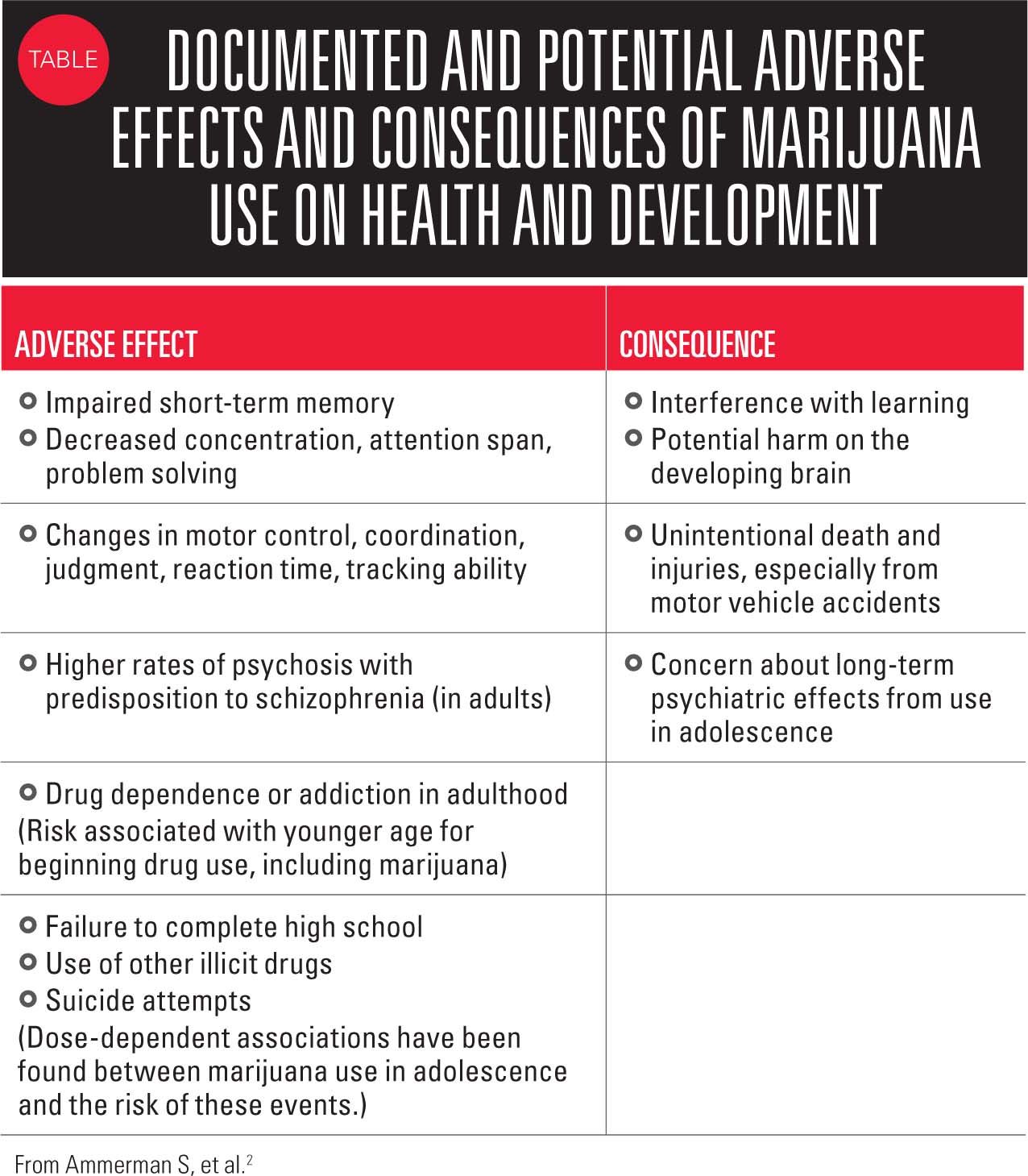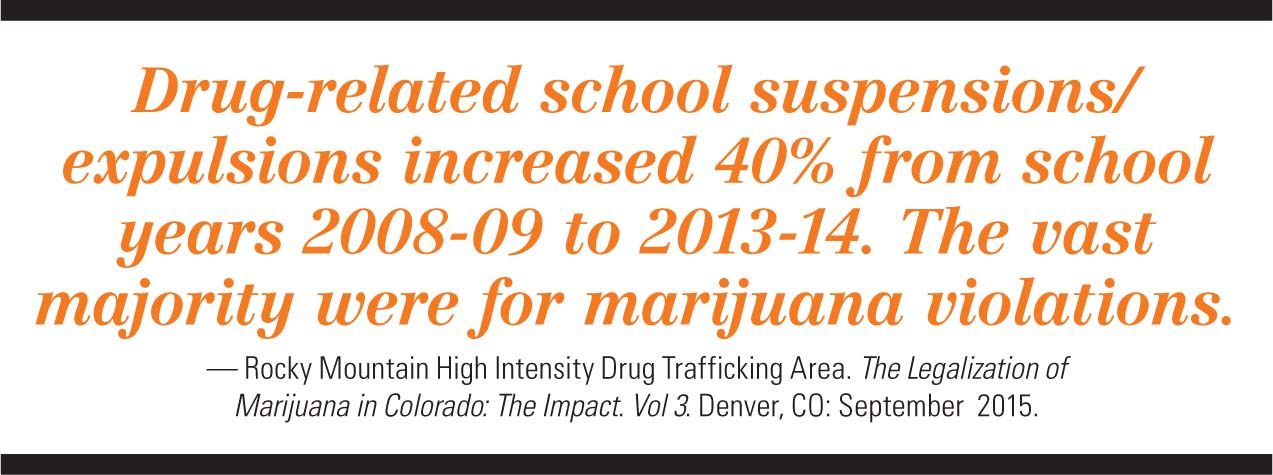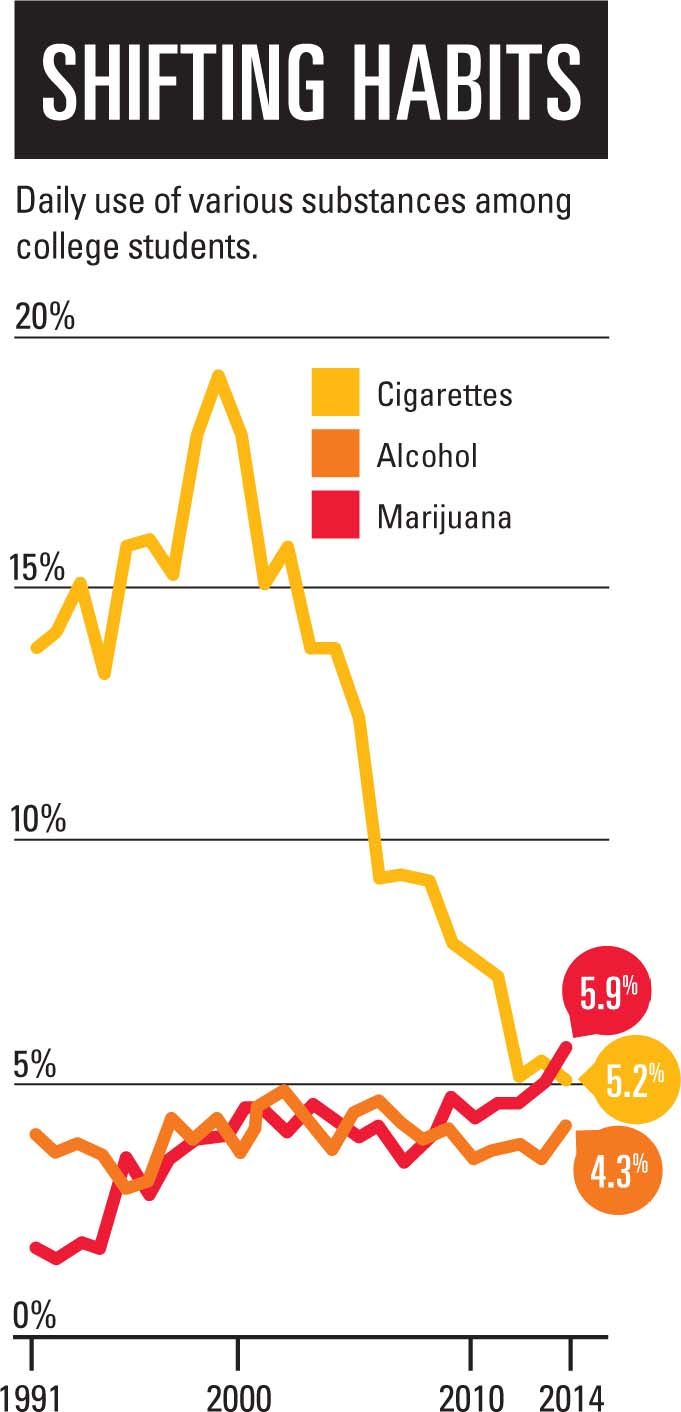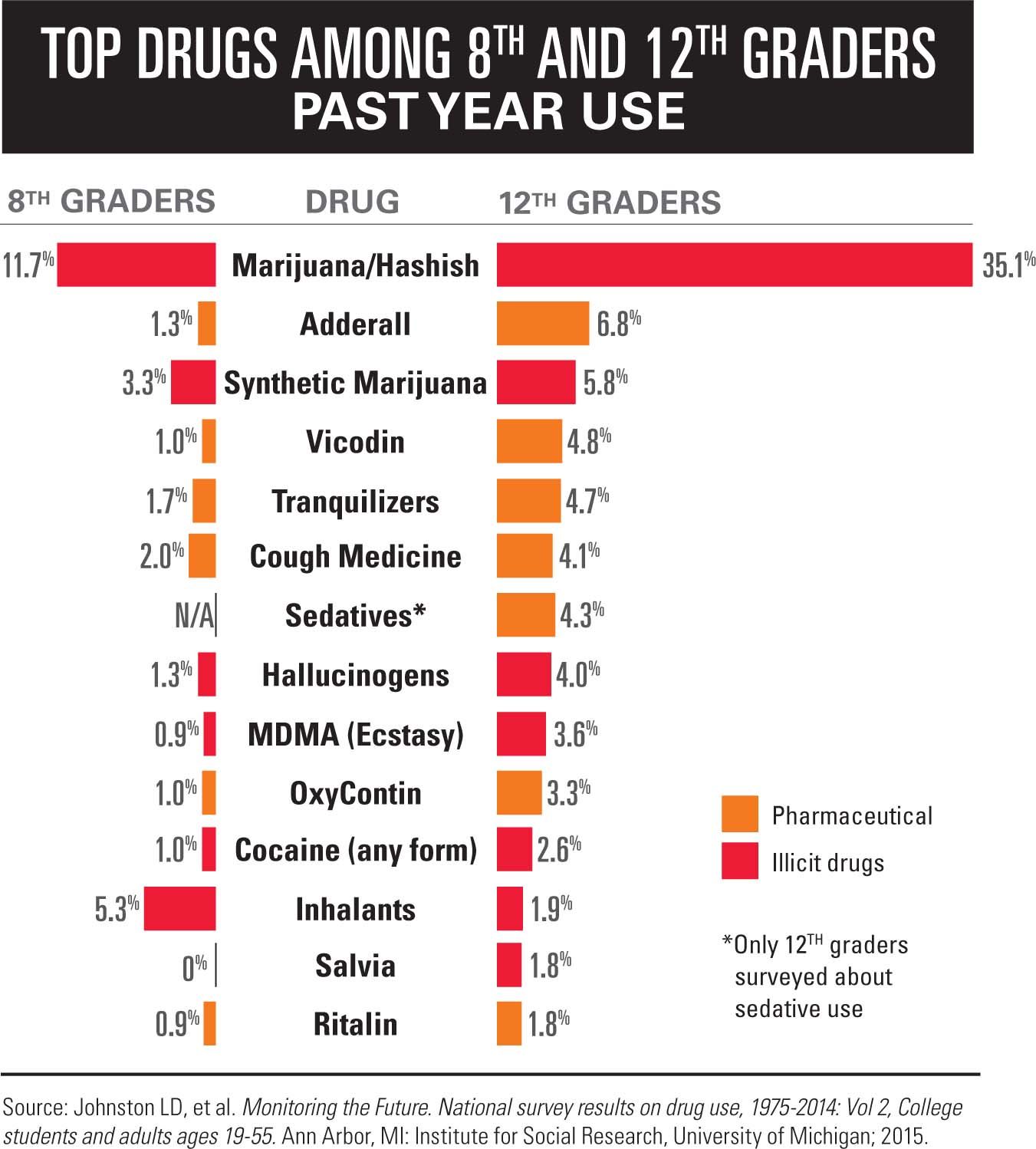Why AAP opposes marijuana use and legalization
As of December 2015, medical marijuana is legalized in 23 states and the District of Columbia, and in 4 of those states along with in the District of Columbia, marijuana is legalized for recreational use.
Reviewed by Seth Ammerman, MD
As of December 2015, medical marijuana is legalized in 23 states and the District of Columbia, and in 4 of those states along with in the District of Columbia, marijuana is legalized for recreational use.1 Residents in more states will be voting on the legalization of marijuana in 2016, and local governments are increasingly decriminalizing possession of small amounts of marijuana for recreational use.
Recognizing the potential for changes in legal status of marijuana to impact use among minors and that pediatricians may be sought out by legislators and parents for advice about marijuana legalization, the American Academy of Pediatrics (AAP) undertook an update of its 2004 policy statement, “The impact of marijuana policies in youth.” The updated policy statement and an accompanying technical report were both published online in January 2015 and in print in the March 2015 issue of Pediatrics.2,3
Related: Talking to teens about marijuana
This article summarizes the policy statement recommendations and features excerpts from an interview with Seth Ammerman, MD, who is lead author of the policy statement and technical report and clinical professor of pediatrics and adolescent medicine, Stanford University School of Medicine, Stanford, California. He spoke to Contemporary Pediatrics about the development of the updated AAP Policy Statement and Technical Report, highlighted some of its major elements, and offered key messages for practicing pediatricians.
Recommendations
In the 2015 policy statement, the AAP makes 10 recommendations relating to its positions on marijuana use and decriminalization; actions to protect children residing in states where marijuana is legalized for medical or recreational purposes; the development of pharmaceutical cannabinoids; and research on the benefits and risks of marijuana.
In its recommendations, the AAP opposes:
- Marijuana use by children and adolescents (aged through 21 years) given evidence on the negative health and brain development effects.
- Medical marijuana use outside the regulatory process of the US Food and Drug Administration (FDA), although it recognizes it may be an option for children with life-limiting or severely debilitating conditions for whom current therapies are inadequate.
- Legalization of marijuana because of the potential harms to children and adolescents.
- Use of smoked marijuana because smoking causes lung damage.
NEXT: What does the policy recommend supporting and encouraging?
The policy recommendations also support/encourage:
- Research and development of pharmaceutical cannabinoids and changing the US Drug Enforcement Administration (DEA) classification of marijuana from Schedule I to Schedule II to enable this research.
- Decriminalization of marijuana use for minors and young adults.
- Pediatricians’ efforts to advocate for laws preventing harsh criminal penalties for possession or use of marijuana.
- A focus on treatment rather than criminal penalties for adolescents with marijuana use problems.
- Further research of the effects of legalization on adolescent use and to reduce such use.
To protect children in states where marijuana is legalized, the AAP recommends:
- Strict enforcement of rules and regulations that limit access and marketing and advertising to children and adolescents.
- Regulation of the sale of marijuana products, with a minimum age of 21 years for purchase, strict penalties for offenders, and use of revenue from offender penalties to support research on marijuana health risks and benefits.
- Distribution of marijuana in childproof packaging.
More: What teens need to know about 'dabbing'
The AAP discourages marijuana use by adults in the presence of minors considering that adult role modeling can influence child and adolescent behavior.

The technical report on the impact of marijuana policies on youth provides evidence that served as the foundation for the updated AAP policy. Its contents review the known and potential effects of marijuana use on health and development (Table).2 In addition, the technical report provides information on the epidemiology of marijuana use among children and adolescents; presents definitions of cannabinoids, marijuana, and related terms (tetrahydrocannabinol, hemp); reviews cannabinoid therapeutics; presents background and issues relating to marijuana legalization and decriminalization; compares marijuana-related issues with those involving alcohol and tobacco; and addresses society and social justice considerations.

The AAP also has developed a “speaking points” document to assist pediatricians in talking about marijuana. It is accessible to AAP members through the organization’s website, www.aap.org.
In addition, an AAP clinical report is forthcoming that will provide specific counseling guidelines and tips for pediatricians as they speak to parents and patients about marijuana use in the current era of its legalization.
NEXT: Discussion with Seth Ammerman, MD

Q. When did the AAP committees begin their work revisiting the topic of the impact of marijuana on youth, and what prompted this undertaking?
A. The effort began in 2011 and was based on recognition that the marijuana landscape had changed significantly since the first AAP policy statement was released in 2004. More and more states were legalizing medical marijuana, and we knew legalization of recreational use of marijuana by adults was coming. Considering the potential for the changing legal status of marijuana to affect prevalence of youth use, the AAP felt that it was very important for pediatricians to be informed and have a voice in the discussion.
The entire process took about 3.5 years to complete. There was a spectrum of opinions about a variety of issues among the individuals involved in developing the policy statement. The final recommendations represent a consensus based on the best available evidence.
Q. What is new in the 2015 policy statement recommendations?
A. There are a few significant differences. First, however, I think it is important to point out that the AAP’s position against legalization of marijuana did not change. That is because the AAP wanted to take a cautious stance at a time when marijuana legalization is increasing in states nationwide, given the concerns and unknowns about both the potential harms to children and adolescents and how the prevalence of marijuana use in this population could be impacted by legalization. In addition, we also felt it will be important to see if, with legalization, regulations will be enacted providing for youth education, prevention and early treatment, and then to see what does and does not work.
More: Marijuana legalization puts kids in harm's way
Right now recreational use of marijuana by adults is legalized in Alaska, Colorado, Oregon, Washington, and the District of Columbia. In 2016, it will almost certainly be on the ballot in California where it is likely to pass, and that will be a major development considering the size of the population and the influence events in California can have elsewhere in the nation.
As the first state to legalize recreational marijuana for adults, Colorado is now starting to gather data to understand its impact. However, it will take some time until we know how it is affecting use by youth.
In terms of major changes, the recommendation strongly supporting decriminalization is entirely new as decriminalization was not addressed in any way in the 2004 policy statement. It was very clear, however, in reviewing information for the update that criminalizing minors for marijuana possession has a hugely negative impact on them psychosocially, academically, and at other levels. It is absurd for actions on possession of small amounts of marijuana to fall under the purview of the criminal justice system and to penalize kids with harsh measures that can adversely affect them their entire life. Rather, the members of the committees developing the policy statement felt strongly that addressing marijuana possession is a public health issue. Thus, the recommendation supports decriminalization and encourages that kids who have problems with marijuana use will get the help they need so that they ultimately can lead happy, healthy, and productive adult lives.
NEXT: Changing the schedule classification

The recommendation to change the DEA classification from Schedule I to Schedule II is another major change in the updated policy. In this regard, I want to point out that “medical marijuana” is a misnomer. When it comes to pharmacologic effects, what we are really talking about are the cannabinoids, which are the active ingredients in the cannabis plant. So far, about 200 such compounds have been identified, but we know little about most of them. The 2 most notable exceptions are tetrahydrocannabinol, which is the primary psychoactive agent, and cannabidiol, which does not have psychoactive effects but is being investigated as a treatment for intractable seizures in children.

The point is that some cannabinoids may have therapeutic or medical benefits, but their Schedule I classification has significantly limited research. Rescheduling to class II should facilitate that research and development of a compound with the necessary data pertaining to efficacy, safety, dosing, and purity that will be able to go through the FDA approval process.
The statement about considering “medical marijuana” for use in children with life-limiting or severely debilitating illnesses is also new in the 2015 policy statement. We recognized there may be a role for marijuana in those situations, but only after standard treatments have been tried and found inadequate.
Q. How should pediatricians in the community implement the information in the AAP policy statement into patient care?
A. Pediatricians need to be up-to-date on this topic and understand the concerns about marijuana because screening for substance abuse, including marijuana, is a standard of care as part of anticipatory guidance given at annual visits or at any visit where there is suspicion of substance use.
The vast majority of pediatricians think that any drug use by kids-whether tobacco, alcohol, marijuana, or others-is not healthy. In the general public, however, there is a sense that marijuana, especially for adults, is a relatively benign substance. In fact, marijuana is often cast in a positive light by individuals who compare it with alcohol, saying alcohol causes more problems for individuals and society. While there may be some truth to those arguments in terms of adults, we know there may be some serious consequences when marijuana is used on a regular (10 to 19 times/month) or heavy (20 or more times/month) basis by youth in terms of effects on brain development and mental health as well as academically and psychosocially.
Next: Where's the evidence base for medical marijuana?
Therefore, pediatricians should be emphasizing to parents and their patients that marijuana is not necessarily a benign substance; that it can be addicting and cause problems; and that children, teenagers, and young adults need to be making healthy choices, including not using marijuana on a regular basis.
Q. What other take-home messages do you have for pediatricians?
A. In both the policy statement and technical report, we are definitely advocating for pediatricians to get involved with decriminalization efforts. Decriminalization occurs at the state and local government levels, and with the AAP being divided into state chapters and districts, it is our hope that members of those groups will take an active role in advocating for decriminalization of marijuana possession for kids.
Q. More than a decade passed between publication of the first AAP policy statement on marijuana impact on youth and the update. Do you foresee that this topic will be reexamined sooner than before?
A. The landscape is changing rapidly now, and the AAP may well revisit its advocacy position and/or the policy statement sooner, depending on what information emerges on the impact of legalization of medical marijuana and recreational marijuana. So far, looking at states where medical marijuana is legalized, it looks as if youth use rates have not significantly increased. That is an encouraging trend, but it is still too early to reach any conclusions, and we have no data yet on how legalization of marijuana for recreational use by adults will affect use among youth.
REFERENCES
1. American Academy of Pediatrics. State marijuana laws. Available at: https://www.aap.org/en-us/advocacy-and-policy/state-advocacy/Documents/State%20Marijuana%20Laws.pdf. Published December 2015. Accessed January 16, 2016.
2. Ammerman S, Ryan S, Adelman WP; Committee on Substance Abuse; Committee on Adolescence. Policy statement. The impact of marijuana policies on youth: clinical, research, and legal update. Pediatrics. 2015;135(3):584-587. Available at: http://pediatrics.aappublications.org/content/135/3/584.long. Accessed January 16, 2016.
3. Ammerman S, Ryan S, Adelman WP; Committee on Substance Abuse, the Committee on Adolescence. Technical report. The impact of marijuana policies on youth: clinical, research, and legal update. Pediatrics. 2015;135(3):e769-e785. Available at: http://pediatrics.aappublications.org/content/135/3/e769.long. Accessed January 16, 2016.
Ms Krader has 30 years’ experience as a medical writer. She has worked as both a hospital pharmacist and a clinical researcher/writer for the pharmaceutical industry and is presently a freelance writer in Deerfield, Illinois. She has nothing to disclose in regard to affiliations with or financial interests in any organizations that may have an interest in any part of this article.